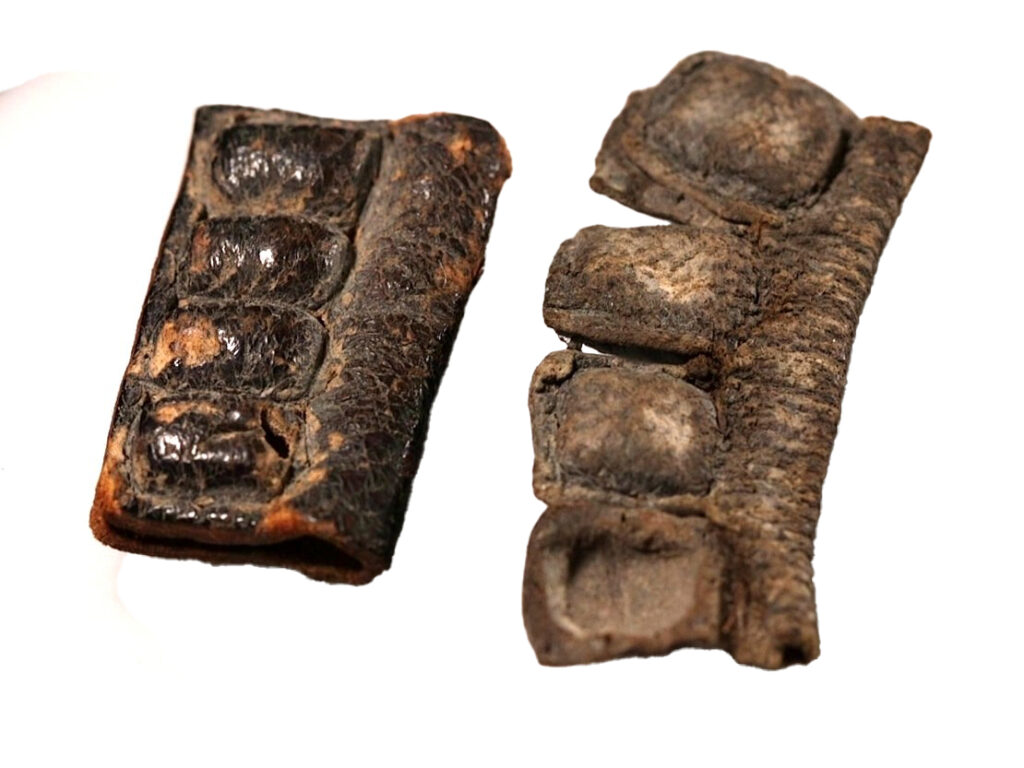Tefillin are small leather cases containing minuscule parchment scrolls inscribed with biblical verses. They are worn until today by observant Jews as part of their morning prayers, one on the head and one on the arm. According to Jewish law, the tefillin cases should be colored black.

Modern tefillin – painted black. Photo: Emil Aladjem, Israel Antiquities Authority
However, a team of researchers from Israel and Great Britain has conducted a battery of scientific tests that showed that ancient tefillin was not blackened. The research was led by Prof. Yonatan Adler of Ariel University, together with Dr. Ilit Cohen-Ofri and Dr. Yonah Maor of the Israel Antiquities Authority, Dr. Theresa Emmerich Kamper of the University of Exeter, and Dr. Iddo Pinkas of the Weizmann Institute of Science.

Prof. Yonatan Adler. Photo: Photo: Kaitlyn Casso
In 1949, archaeologists discovered several leather tefillin cases in a cave near Qumran, where the first Dead Sea Scrolls were found. Subsequently, additional tefillin cases were unearthed in other caves near Qumran, in Wadi Murabba‘at and in Nahal Se’elim—all in the Judean Desert. These findings are dated to the same time as the Dead Sea Scrolls, from around the end of the Second Temple period—or about 2,000 years ago.

Tefillin from about 2,000 years ago in the laboratories of the Israel Antiquities Authority. Photo: Emil Aladjem, Israel Antiquities Authority
The arid desert climate allowed these artifacts to survive for millennia until their discovery. Today, the tefillin cases are preserved in the storeroom of the Israel Antiquities Authority’s Dead Sea Scrolls Unit in Jerusalem, where the climatic conditions of the caves are replicated.

Tefillin from about 2,000 years ago in the laboratories of the Israel Antiquities Authority. Photo: Emil Aladjem, Israel Antiquities Authority
“This is a very important discovery,” explained Professor Yonatan Adler of Ariel University, who led the study. “This is the first time tefillin has been scientifically examined to determine its color. In some of the ancient tefillin, the leather has a natural brown color. However, in others, the very dark color of the leather was previously thought to be the result of artificial dyeing, which was done to comply with the law that requires the leather of tefillin cases to be black. Our tests have shown that where the leather appears dark, it results from a natural process and not intentional dyeing.”
According to Dr. Ilit Cohen-Ofri, head of the conservation laboratory at the Israel Antiquities Authority’s Dead Sea Scrolls Unit: “In ancient times, there were two main methods for dyeing leather black. The first method used carbon-based materials—soot or charcoal—to give the leather a black color. The second method was based on a chemical reaction between tannin, a complex organic compound found in many plants, and iron oxides. In our tests, we ruled out the possibility that the tefillin cases were dyed black using either of these methods.”
The researchers used various techniques, including multispectral imaging, Raman spectroscopy, FTIR-ATR, and SEM/EDX, to examine the leather of the tefillin cases for traces of black dye or paint. The analyses showed no evidence of black colorants in tefillin cases.
“In the dark fragments we examined,” says Dr. Yonah Maor of the Israel Antiquities Authority’s analytical laboratory, “the color appears to be the result of natural leather aging rather than intentional dyeing. Minor water leakage into the caves over the 2,000 years the artifacts have been there could have accelerated the leather aging process. In the past, we have found that some of the Dead Sea Scrolls have also undergone a similar process, which unfortunately has caused the parchment to darken.”
The researchers believe that the practice of coloring tefillin cases black is likely due to a later tradition. They suggest that the law requiring tefillin to be made black may not have been in place in the Second Temple period, when the ancient tefillin examined in the study were in use.
“It is likely that in the beginning, there was no halakhic significance to the color of tefillin,” explained Professor Adler. “Only at a later period did the rabbis rule that tefillin should be colored black. However, even after this, the halakhic authorities continued to debate whether the requirement to color tefillin cases black was an absolute obligation or merely preferable for aesthetic reasons. It is commonly thought that Jewish law is static and does not develop. Our ongoing research on ancient tefillin shows that the exact opposite is true; Jewish law has always been dynamic. In my view, it is this vibrancy that makes halakhah so beautiful.”




